Unilever: Talent Management Challenges in the Manufacturing Sector
VerifiedAdded on 2022/12/23
|18
|3367
|58
Report
AI Summary
This report investigates the challenges of talent management within Unilever, a multinational consumer goods manufacturing company. The study explores the core concepts of talent management, including talent acquisition, learning and development, and performance management, and analyzes how poor talent management impacts Unilever's performance. The research utilizes a qualitative approach, incorporating primary data collected through questionnaires and secondary data from literature reviews. Findings are presented using various tools, identifying key challenges such as poor productivity, a negative company image, and high staff turnover. The report recommends strategies for improving talent management, including effective recruitment, employee motivation, and performance appraisal, with the aim of increasing staff retention and overall company success. The report includes a project development plan, work breakdown structure, Gantt chart, and reflection on the value of the undertaking.
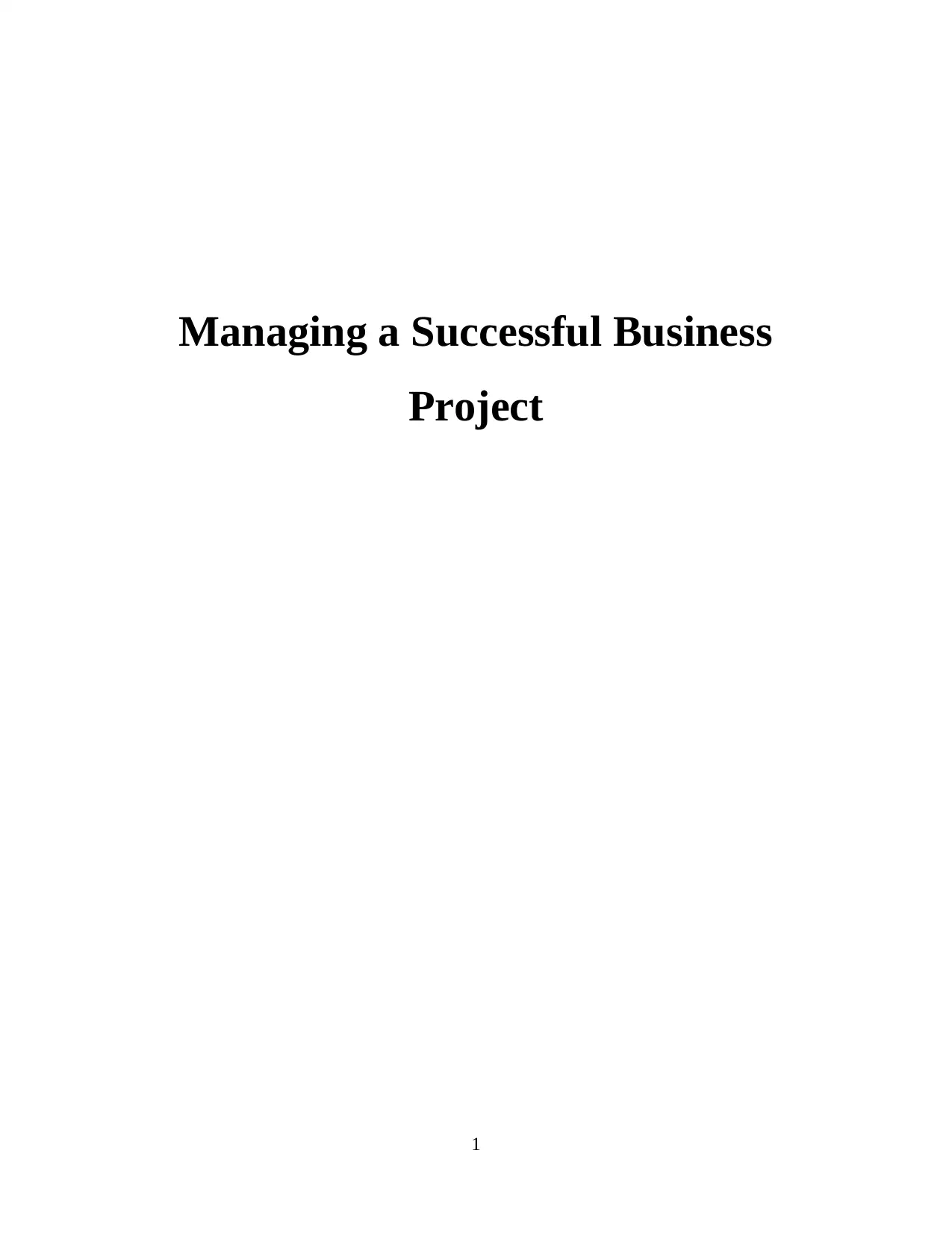
Managing a Successful Business
Project
1
Project
1
Paraphrase This Document
Need a fresh take? Get an instant paraphrase of this document with our AI Paraphraser
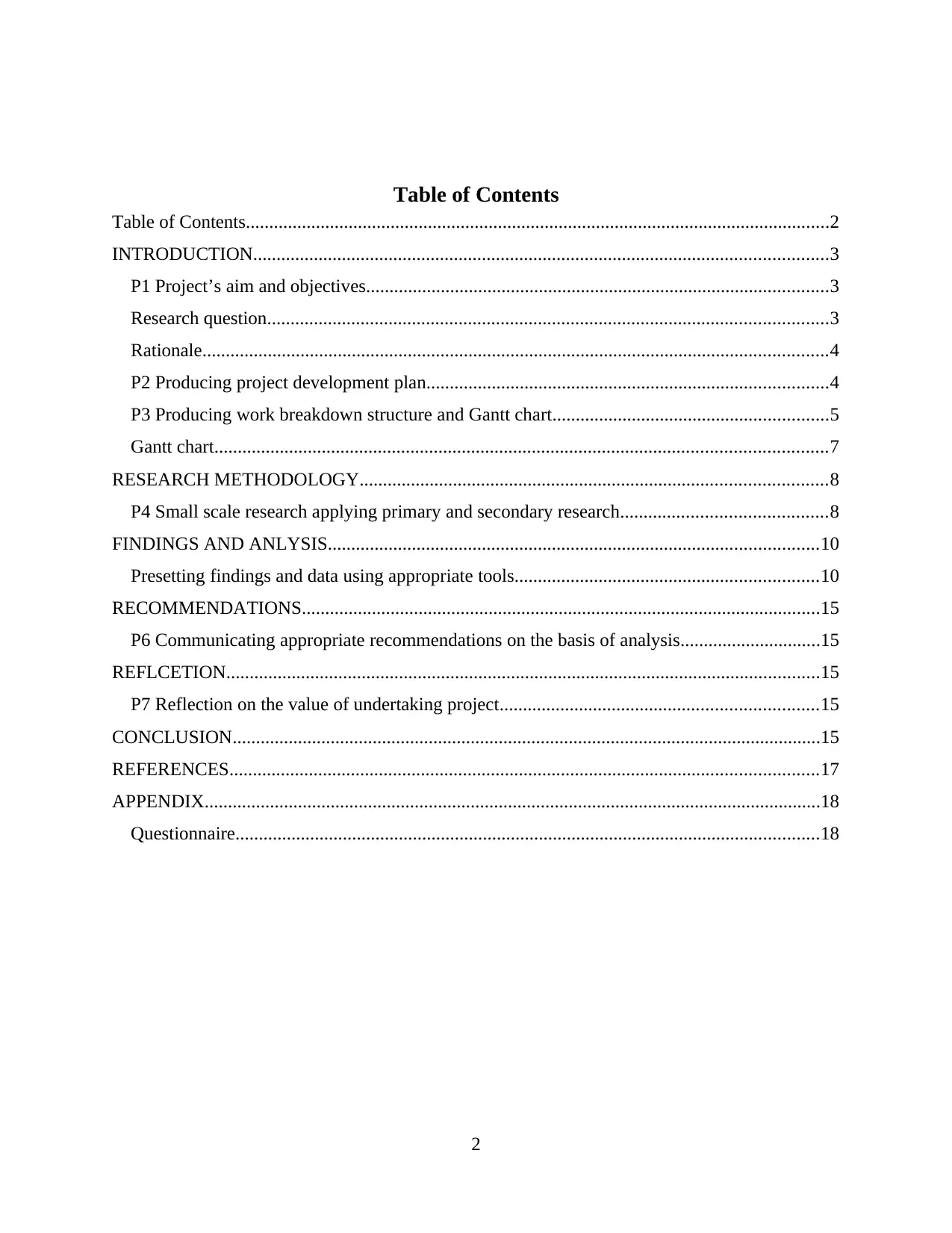
Table of Contents
Table of Contents.............................................................................................................................2
INTRODUCTION...........................................................................................................................3
P1 Project’s aim and objectives...................................................................................................3
Research question........................................................................................................................3
Rationale......................................................................................................................................4
P2 Producing project development plan......................................................................................4
P3 Producing work breakdown structure and Gantt chart...........................................................5
Gantt chart...................................................................................................................................7
RESEARCH METHODOLOGY....................................................................................................8
P4 Small scale research applying primary and secondary research............................................8
FINDINGS AND ANLYSIS.........................................................................................................10
Presetting findings and data using appropriate tools.................................................................10
RECOMMENDATIONS...............................................................................................................15
P6 Communicating appropriate recommendations on the basis of analysis..............................15
REFLCETION...............................................................................................................................15
P7 Reflection on the value of undertaking project....................................................................15
CONCLUSION..............................................................................................................................15
REFERENCES..............................................................................................................................17
APPENDIX....................................................................................................................................18
Questionnaire.............................................................................................................................18
2
Table of Contents.............................................................................................................................2
INTRODUCTION...........................................................................................................................3
P1 Project’s aim and objectives...................................................................................................3
Research question........................................................................................................................3
Rationale......................................................................................................................................4
P2 Producing project development plan......................................................................................4
P3 Producing work breakdown structure and Gantt chart...........................................................5
Gantt chart...................................................................................................................................7
RESEARCH METHODOLOGY....................................................................................................8
P4 Small scale research applying primary and secondary research............................................8
FINDINGS AND ANLYSIS.........................................................................................................10
Presetting findings and data using appropriate tools.................................................................10
RECOMMENDATIONS...............................................................................................................15
P6 Communicating appropriate recommendations on the basis of analysis..............................15
REFLCETION...............................................................................................................................15
P7 Reflection on the value of undertaking project....................................................................15
CONCLUSION..............................................................................................................................15
REFERENCES..............................................................................................................................17
APPENDIX....................................................................................................................................18
Questionnaire.............................................................................................................................18
2
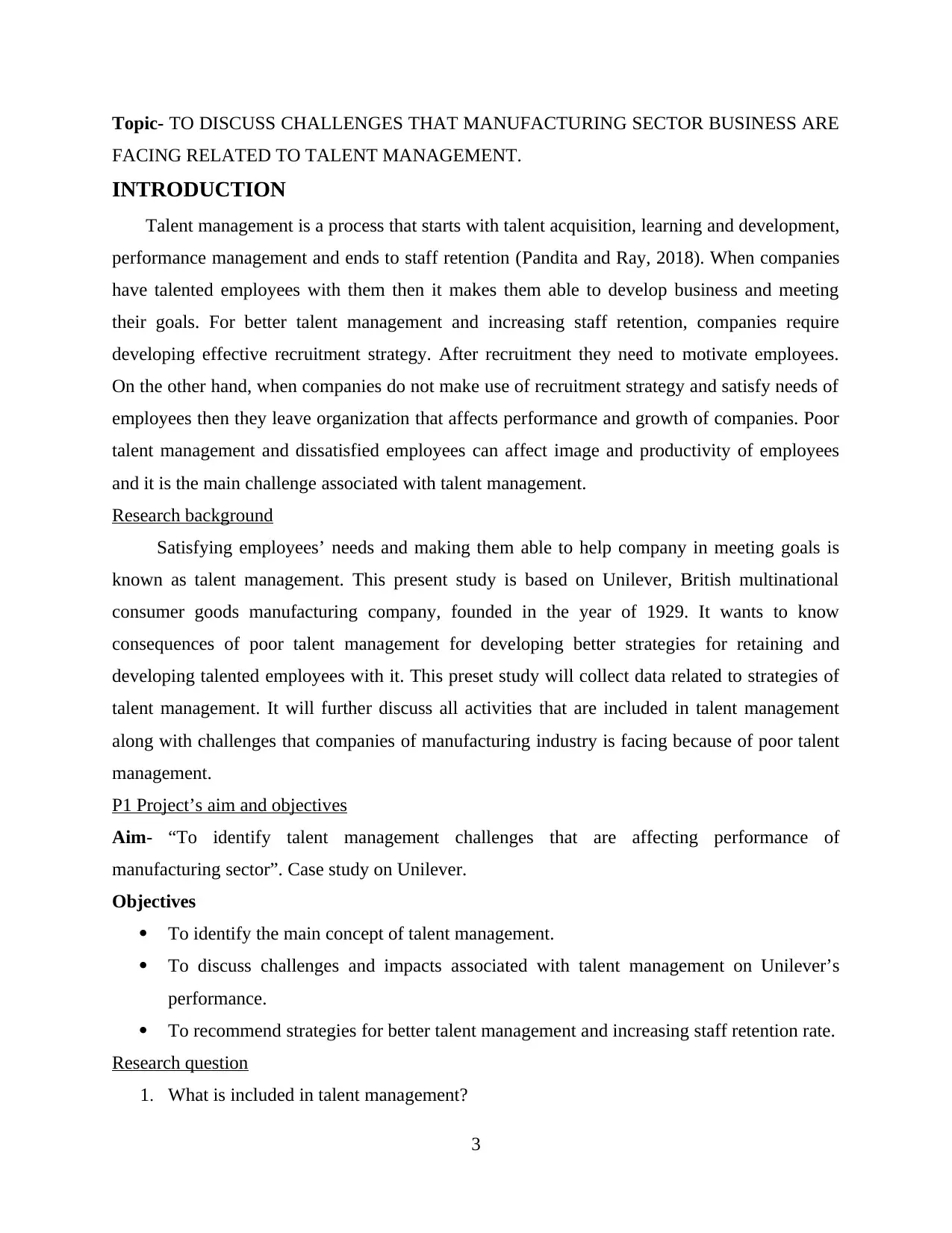
Topic- TO DISCUSS CHALLENGES THAT MANUFACTURING SECTOR BUSINESS ARE
FACING RELATED TO TALENT MANAGEMENT.
INTRODUCTION
Talent management is a process that starts with talent acquisition, learning and development,
performance management and ends to staff retention (Pandita and Ray, 2018). When companies
have talented employees with them then it makes them able to develop business and meeting
their goals. For better talent management and increasing staff retention, companies require
developing effective recruitment strategy. After recruitment they need to motivate employees.
On the other hand, when companies do not make use of recruitment strategy and satisfy needs of
employees then they leave organization that affects performance and growth of companies. Poor
talent management and dissatisfied employees can affect image and productivity of employees
and it is the main challenge associated with talent management.
Research background
Satisfying employees’ needs and making them able to help company in meeting goals is
known as talent management. This present study is based on Unilever, British multinational
consumer goods manufacturing company, founded in the year of 1929. It wants to know
consequences of poor talent management for developing better strategies for retaining and
developing talented employees with it. This preset study will collect data related to strategies of
talent management. It will further discuss all activities that are included in talent management
along with challenges that companies of manufacturing industry is facing because of poor talent
management.
P1 Project’s aim and objectives
Aim- “To identify talent management challenges that are affecting performance of
manufacturing sector”. Case study on Unilever.
Objectives
To identify the main concept of talent management.
To discuss challenges and impacts associated with talent management on Unilever’s
performance.
To recommend strategies for better talent management and increasing staff retention rate.
Research question
1. What is included in talent management?
3
FACING RELATED TO TALENT MANAGEMENT.
INTRODUCTION
Talent management is a process that starts with talent acquisition, learning and development,
performance management and ends to staff retention (Pandita and Ray, 2018). When companies
have talented employees with them then it makes them able to develop business and meeting
their goals. For better talent management and increasing staff retention, companies require
developing effective recruitment strategy. After recruitment they need to motivate employees.
On the other hand, when companies do not make use of recruitment strategy and satisfy needs of
employees then they leave organization that affects performance and growth of companies. Poor
talent management and dissatisfied employees can affect image and productivity of employees
and it is the main challenge associated with talent management.
Research background
Satisfying employees’ needs and making them able to help company in meeting goals is
known as talent management. This present study is based on Unilever, British multinational
consumer goods manufacturing company, founded in the year of 1929. It wants to know
consequences of poor talent management for developing better strategies for retaining and
developing talented employees with it. This preset study will collect data related to strategies of
talent management. It will further discuss all activities that are included in talent management
along with challenges that companies of manufacturing industry is facing because of poor talent
management.
P1 Project’s aim and objectives
Aim- “To identify talent management challenges that are affecting performance of
manufacturing sector”. Case study on Unilever.
Objectives
To identify the main concept of talent management.
To discuss challenges and impacts associated with talent management on Unilever’s
performance.
To recommend strategies for better talent management and increasing staff retention rate.
Research question
1. What is included in talent management?
3
⊘ This is a preview!⊘
Do you want full access?
Subscribe today to unlock all pages.

Trusted by 1+ million students worldwide
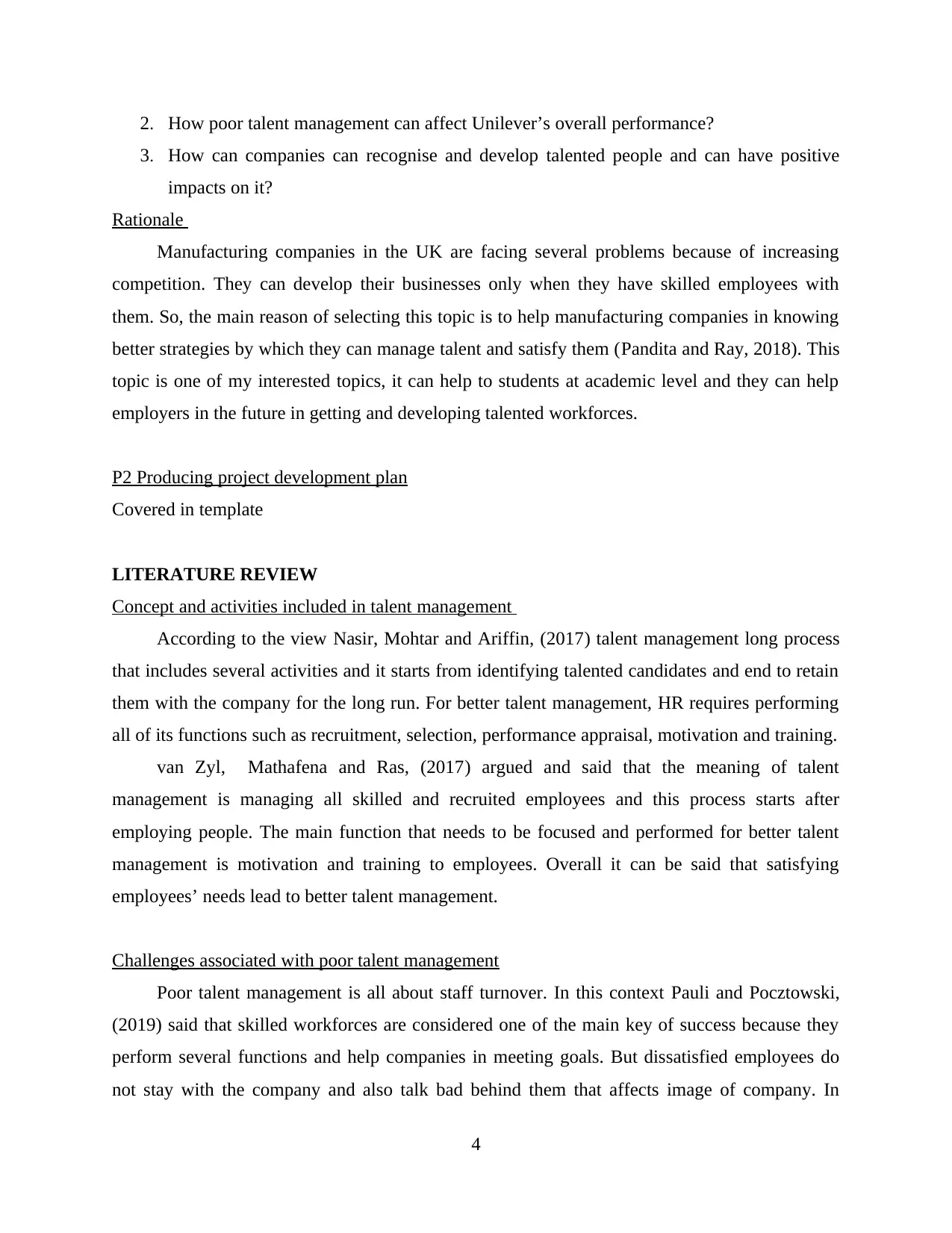
2. How poor talent management can affect Unilever’s overall performance?
3. How can companies can recognise and develop talented people and can have positive
impacts on it?
Rationale
Manufacturing companies in the UK are facing several problems because of increasing
competition. They can develop their businesses only when they have skilled employees with
them. So, the main reason of selecting this topic is to help manufacturing companies in knowing
better strategies by which they can manage talent and satisfy them (Pandita and Ray, 2018). This
topic is one of my interested topics, it can help to students at academic level and they can help
employers in the future in getting and developing talented workforces.
P2 Producing project development plan
Covered in template
LITERATURE REVIEW
Concept and activities included in talent management
According to the view Nasir, Mohtar and Ariffin, (2017) talent management long process
that includes several activities and it starts from identifying talented candidates and end to retain
them with the company for the long run. For better talent management, HR requires performing
all of its functions such as recruitment, selection, performance appraisal, motivation and training.
van Zyl, Mathafena and Ras, (2017) argued and said that the meaning of talent
management is managing all skilled and recruited employees and this process starts after
employing people. The main function that needs to be focused and performed for better talent
management is motivation and training to employees. Overall it can be said that satisfying
employees’ needs lead to better talent management.
Challenges associated with poor talent management
Poor talent management is all about staff turnover. In this context Pauli and Pocztowski,
(2019) said that skilled workforces are considered one of the main key of success because they
perform several functions and help companies in meeting goals. But dissatisfied employees do
not stay with the company and also talk bad behind them that affects image of company. In
4
3. How can companies can recognise and develop talented people and can have positive
impacts on it?
Rationale
Manufacturing companies in the UK are facing several problems because of increasing
competition. They can develop their businesses only when they have skilled employees with
them. So, the main reason of selecting this topic is to help manufacturing companies in knowing
better strategies by which they can manage talent and satisfy them (Pandita and Ray, 2018). This
topic is one of my interested topics, it can help to students at academic level and they can help
employers in the future in getting and developing talented workforces.
P2 Producing project development plan
Covered in template
LITERATURE REVIEW
Concept and activities included in talent management
According to the view Nasir, Mohtar and Ariffin, (2017) talent management long process
that includes several activities and it starts from identifying talented candidates and end to retain
them with the company for the long run. For better talent management, HR requires performing
all of its functions such as recruitment, selection, performance appraisal, motivation and training.
van Zyl, Mathafena and Ras, (2017) argued and said that the meaning of talent
management is managing all skilled and recruited employees and this process starts after
employing people. The main function that needs to be focused and performed for better talent
management is motivation and training to employees. Overall it can be said that satisfying
employees’ needs lead to better talent management.
Challenges associated with poor talent management
Poor talent management is all about staff turnover. In this context Pauli and Pocztowski,
(2019) said that skilled workforces are considered one of the main key of success because they
perform several functions and help companies in meeting goals. But dissatisfied employees do
not stay with the company and also talk bad behind them that affects image of company. In
4
Paraphrase This Document
Need a fresh take? Get an instant paraphrase of this document with our AI Paraphraser
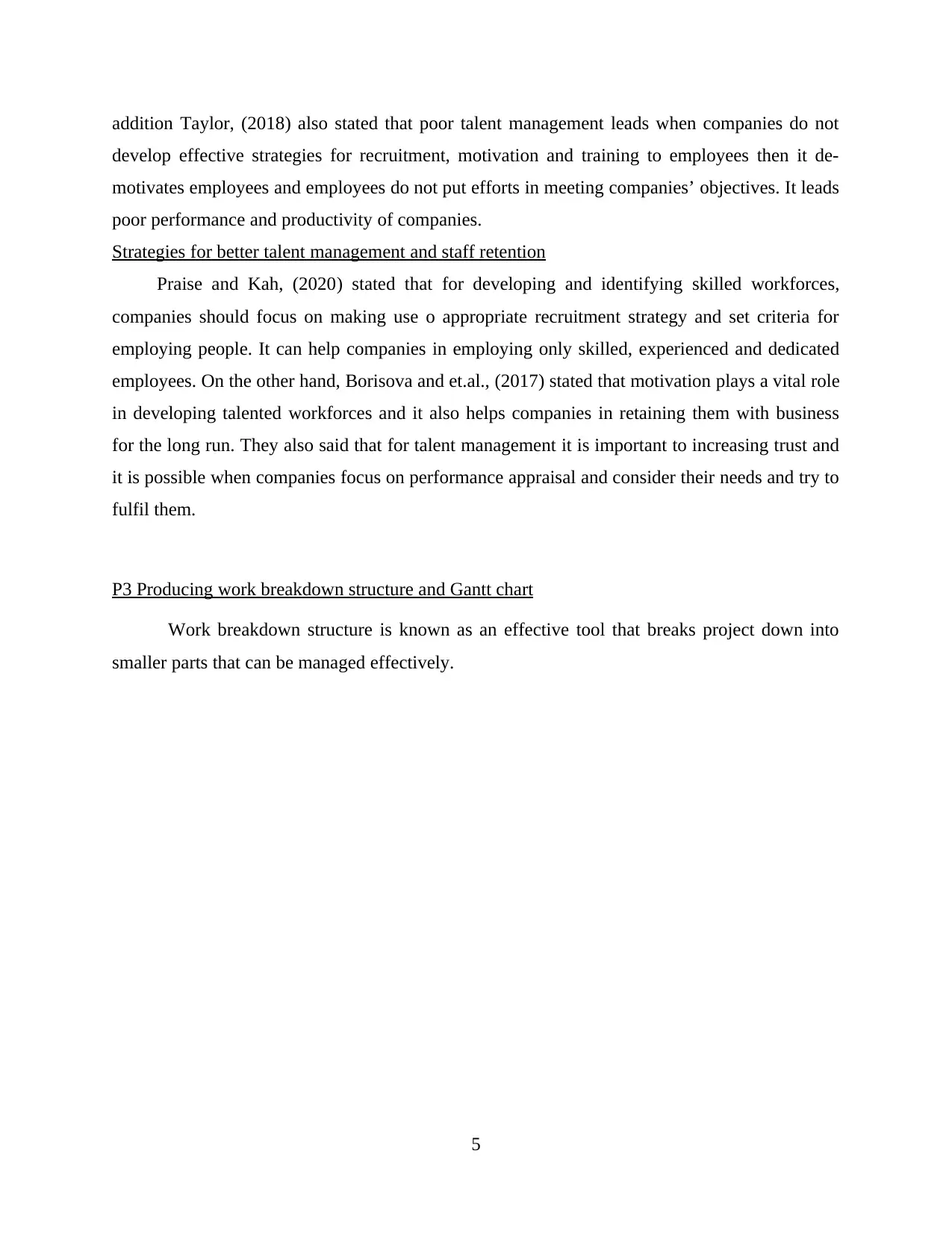
addition Taylor, (2018) also stated that poor talent management leads when companies do not
develop effective strategies for recruitment, motivation and training to employees then it de-
motivates employees and employees do not put efforts in meeting companies’ objectives. It leads
poor performance and productivity of companies.
Strategies for better talent management and staff retention
Praise and Kah, (2020) stated that for developing and identifying skilled workforces,
companies should focus on making use o appropriate recruitment strategy and set criteria for
employing people. It can help companies in employing only skilled, experienced and dedicated
employees. On the other hand, Borisova and et.al., (2017) stated that motivation plays a vital role
in developing talented workforces and it also helps companies in retaining them with business
for the long run. They also said that for talent management it is important to increasing trust and
it is possible when companies focus on performance appraisal and consider their needs and try to
fulfil them.
P3 Producing work breakdown structure and Gantt chart
Work breakdown structure is known as an effective tool that breaks project down into
smaller parts that can be managed effectively.
5
develop effective strategies for recruitment, motivation and training to employees then it de-
motivates employees and employees do not put efforts in meeting companies’ objectives. It leads
poor performance and productivity of companies.
Strategies for better talent management and staff retention
Praise and Kah, (2020) stated that for developing and identifying skilled workforces,
companies should focus on making use o appropriate recruitment strategy and set criteria for
employing people. It can help companies in employing only skilled, experienced and dedicated
employees. On the other hand, Borisova and et.al., (2017) stated that motivation plays a vital role
in developing talented workforces and it also helps companies in retaining them with business
for the long run. They also said that for talent management it is important to increasing trust and
it is possible when companies focus on performance appraisal and consider their needs and try to
fulfil them.
P3 Producing work breakdown structure and Gantt chart
Work breakdown structure is known as an effective tool that breaks project down into
smaller parts that can be managed effectively.
5
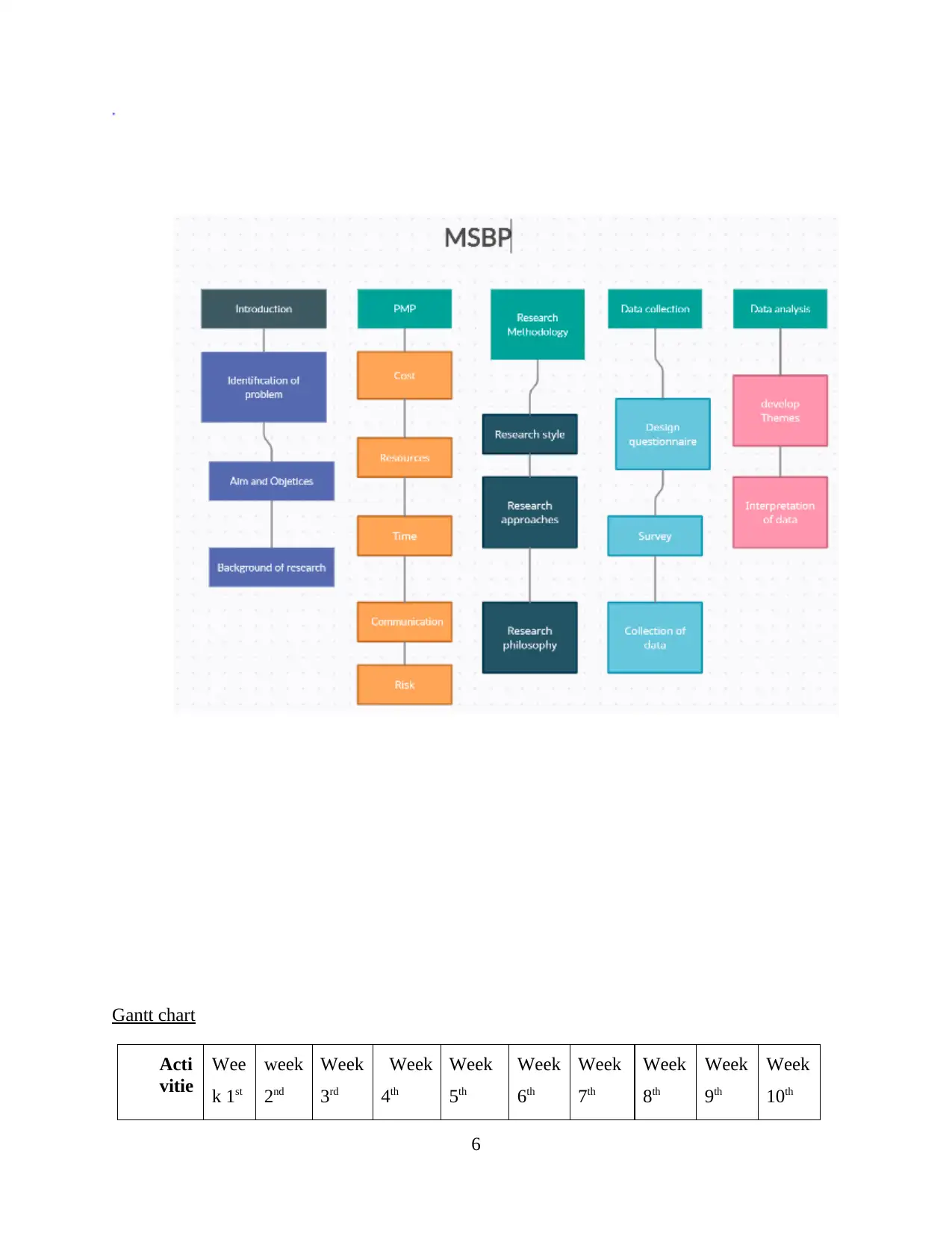
Gantt chart
Acti
vitie
Wee
k 1st
week
2nd
Week
3rd
Week
4th
Week
5th
Week
6th
Week
7th
Week
8th
Week
9th
Week
10th
6
Acti
vitie
Wee
k 1st
week
2nd
Week
3rd
Week
4th
Week
5th
Week
6th
Week
7th
Week
8th
Week
9th
Week
10th
6
⊘ This is a preview!⊘
Do you want full access?
Subscribe today to unlock all pages.

Trusted by 1+ million students worldwide
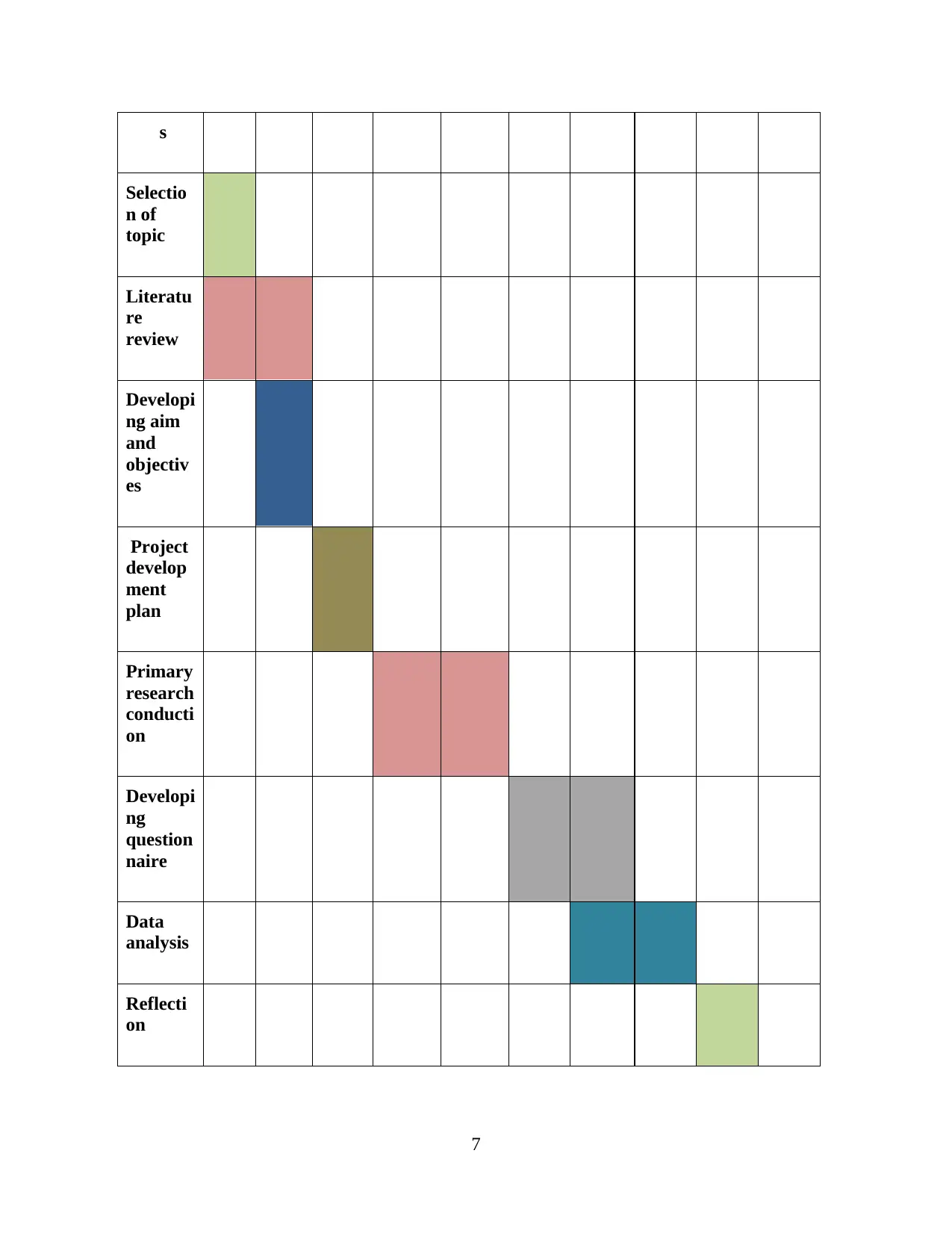
s
Selectio
n of
topic
Literatu
re
review
Developi
ng aim
and
objectiv
es
Project
develop
ment
plan
Primary
research
conducti
on
Developi
ng
question
naire
Data
analysis
Reflecti
on
7
Selectio
n of
topic
Literatu
re
review
Developi
ng aim
and
objectiv
es
Project
develop
ment
plan
Primary
research
conducti
on
Developi
ng
question
naire
Data
analysis
Reflecti
on
7
Paraphrase This Document
Need a fresh take? Get an instant paraphrase of this document with our AI Paraphraser
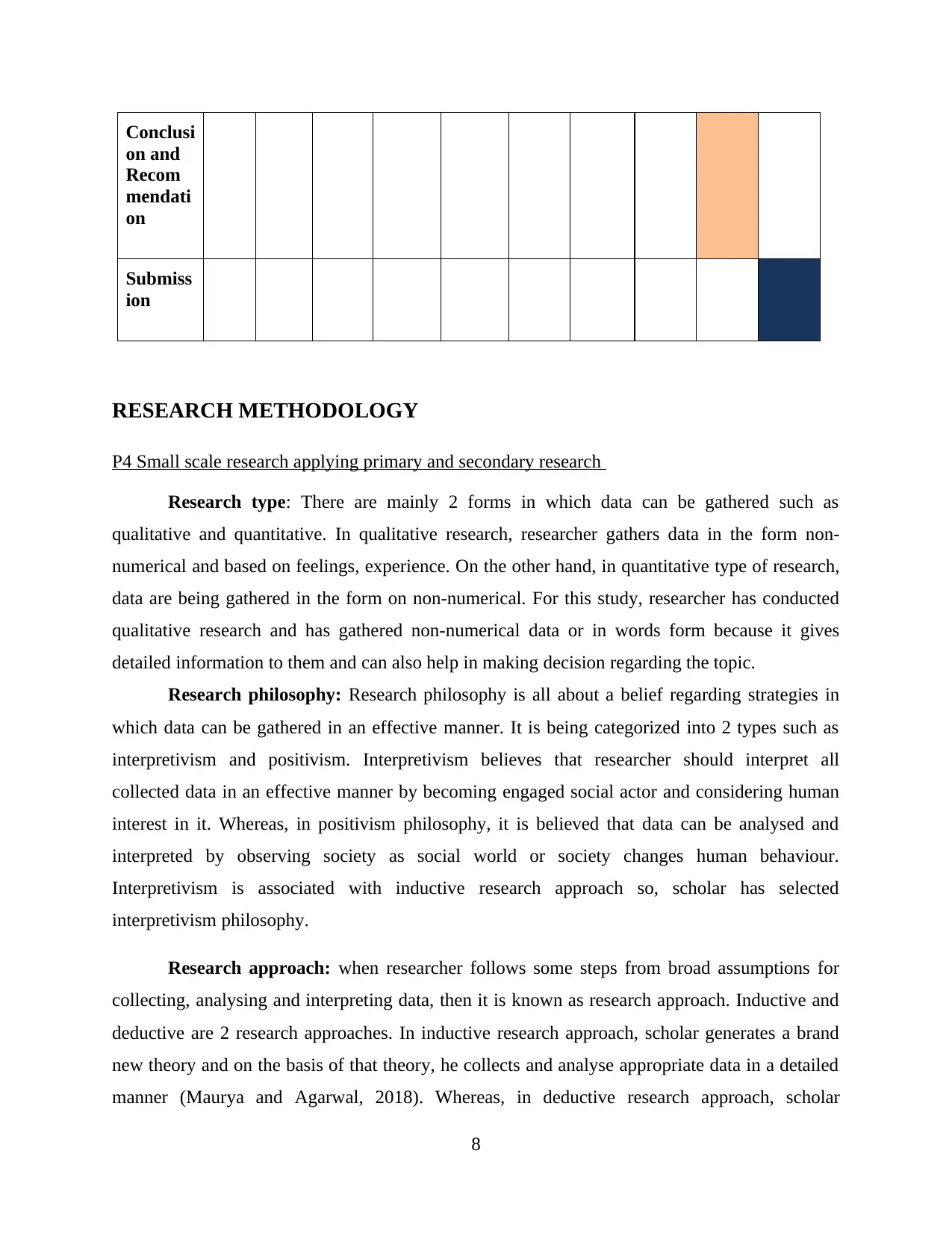
Conclusi
on and
Recom
mendati
on
Submiss
ion
RESEARCH METHODOLOGY
P4 Small scale research applying primary and secondary research
Research type: There are mainly 2 forms in which data can be gathered such as
qualitative and quantitative. In qualitative research, researcher gathers data in the form non-
numerical and based on feelings, experience. On the other hand, in quantitative type of research,
data are being gathered in the form on non-numerical. For this study, researcher has conducted
qualitative research and has gathered non-numerical data or in words form because it gives
detailed information to them and can also help in making decision regarding the topic.
Research philosophy: Research philosophy is all about a belief regarding strategies in
which data can be gathered in an effective manner. It is being categorized into 2 types such as
interpretivism and positivism. Interpretivism believes that researcher should interpret all
collected data in an effective manner by becoming engaged social actor and considering human
interest in it. Whereas, in positivism philosophy, it is believed that data can be analysed and
interpreted by observing society as social world or society changes human behaviour.
Interpretivism is associated with inductive research approach so, scholar has selected
interpretivism philosophy.
Research approach: when researcher follows some steps from broad assumptions for
collecting, analysing and interpreting data, then it is known as research approach. Inductive and
deductive are 2 research approaches. In inductive research approach, scholar generates a brand
new theory and on the basis of that theory, he collects and analyse appropriate data in a detailed
manner (Maurya and Agarwal, 2018). Whereas, in deductive research approach, scholar
8
on and
Recom
mendati
on
Submiss
ion
RESEARCH METHODOLOGY
P4 Small scale research applying primary and secondary research
Research type: There are mainly 2 forms in which data can be gathered such as
qualitative and quantitative. In qualitative research, researcher gathers data in the form non-
numerical and based on feelings, experience. On the other hand, in quantitative type of research,
data are being gathered in the form on non-numerical. For this study, researcher has conducted
qualitative research and has gathered non-numerical data or in words form because it gives
detailed information to them and can also help in making decision regarding the topic.
Research philosophy: Research philosophy is all about a belief regarding strategies in
which data can be gathered in an effective manner. It is being categorized into 2 types such as
interpretivism and positivism. Interpretivism believes that researcher should interpret all
collected data in an effective manner by becoming engaged social actor and considering human
interest in it. Whereas, in positivism philosophy, it is believed that data can be analysed and
interpreted by observing society as social world or society changes human behaviour.
Interpretivism is associated with inductive research approach so, scholar has selected
interpretivism philosophy.
Research approach: when researcher follows some steps from broad assumptions for
collecting, analysing and interpreting data, then it is known as research approach. Inductive and
deductive are 2 research approaches. In inductive research approach, scholar generates a brand
new theory and on the basis of that theory, he collects and analyse appropriate data in a detailed
manner (Maurya and Agarwal, 2018). Whereas, in deductive research approach, scholar
8
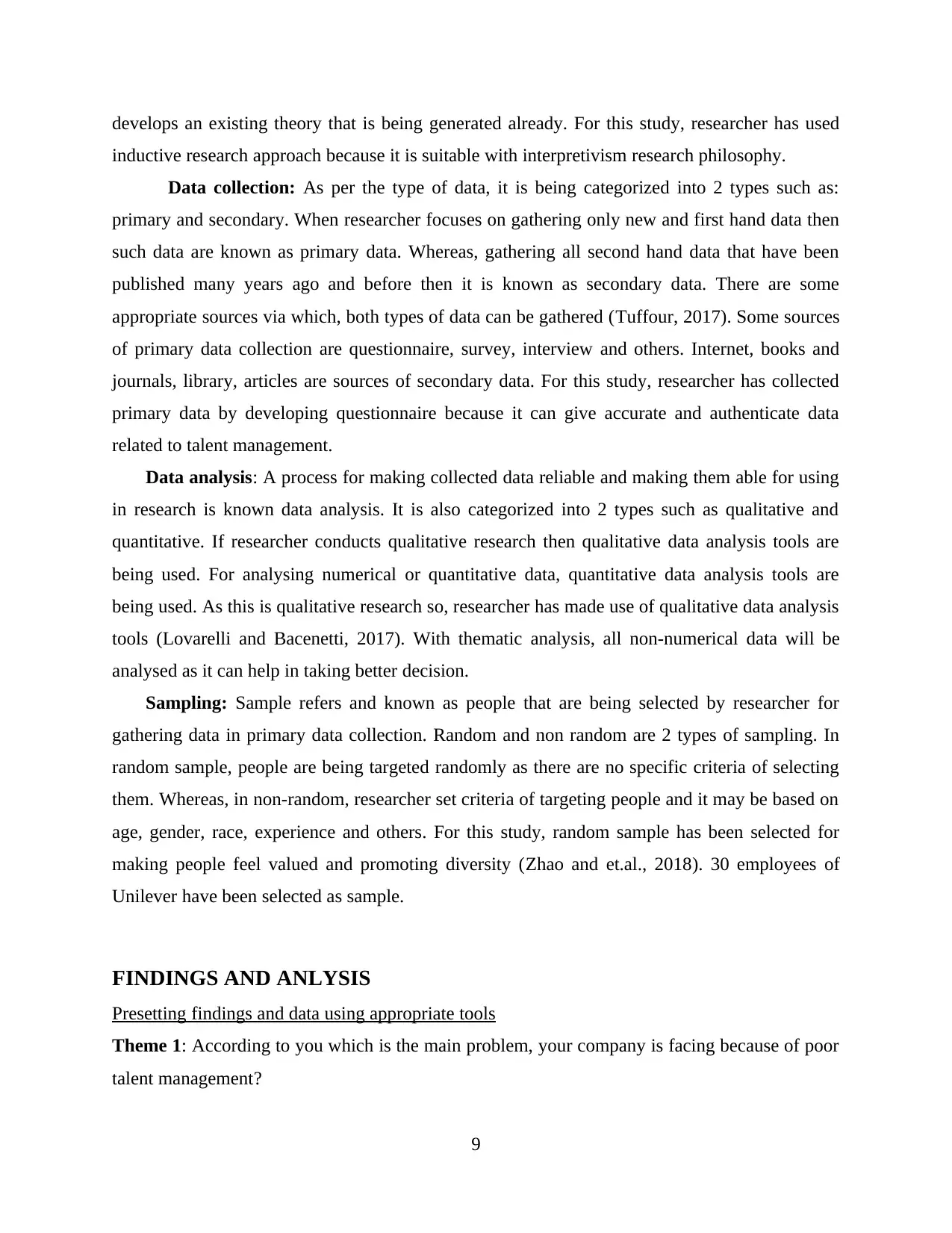
develops an existing theory that is being generated already. For this study, researcher has used
inductive research approach because it is suitable with interpretivism research philosophy.
Data collection: As per the type of data, it is being categorized into 2 types such as:
primary and secondary. When researcher focuses on gathering only new and first hand data then
such data are known as primary data. Whereas, gathering all second hand data that have been
published many years ago and before then it is known as secondary data. There are some
appropriate sources via which, both types of data can be gathered (Tuffour, 2017). Some sources
of primary data collection are questionnaire, survey, interview and others. Internet, books and
journals, library, articles are sources of secondary data. For this study, researcher has collected
primary data by developing questionnaire because it can give accurate and authenticate data
related to talent management.
Data analysis: A process for making collected data reliable and making them able for using
in research is known data analysis. It is also categorized into 2 types such as qualitative and
quantitative. If researcher conducts qualitative research then qualitative data analysis tools are
being used. For analysing numerical or quantitative data, quantitative data analysis tools are
being used. As this is qualitative research so, researcher has made use of qualitative data analysis
tools (Lovarelli and Bacenetti, 2017). With thematic analysis, all non-numerical data will be
analysed as it can help in taking better decision.
Sampling: Sample refers and known as people that are being selected by researcher for
gathering data in primary data collection. Random and non random are 2 types of sampling. In
random sample, people are being targeted randomly as there are no specific criteria of selecting
them. Whereas, in non-random, researcher set criteria of targeting people and it may be based on
age, gender, race, experience and others. For this study, random sample has been selected for
making people feel valued and promoting diversity (Zhao and et.al., 2018). 30 employees of
Unilever have been selected as sample.
FINDINGS AND ANLYSIS
Presetting findings and data using appropriate tools
Theme 1: According to you which is the main problem, your company is facing because of poor
talent management?
9
inductive research approach because it is suitable with interpretivism research philosophy.
Data collection: As per the type of data, it is being categorized into 2 types such as:
primary and secondary. When researcher focuses on gathering only new and first hand data then
such data are known as primary data. Whereas, gathering all second hand data that have been
published many years ago and before then it is known as secondary data. There are some
appropriate sources via which, both types of data can be gathered (Tuffour, 2017). Some sources
of primary data collection are questionnaire, survey, interview and others. Internet, books and
journals, library, articles are sources of secondary data. For this study, researcher has collected
primary data by developing questionnaire because it can give accurate and authenticate data
related to talent management.
Data analysis: A process for making collected data reliable and making them able for using
in research is known data analysis. It is also categorized into 2 types such as qualitative and
quantitative. If researcher conducts qualitative research then qualitative data analysis tools are
being used. For analysing numerical or quantitative data, quantitative data analysis tools are
being used. As this is qualitative research so, researcher has made use of qualitative data analysis
tools (Lovarelli and Bacenetti, 2017). With thematic analysis, all non-numerical data will be
analysed as it can help in taking better decision.
Sampling: Sample refers and known as people that are being selected by researcher for
gathering data in primary data collection. Random and non random are 2 types of sampling. In
random sample, people are being targeted randomly as there are no specific criteria of selecting
them. Whereas, in non-random, researcher set criteria of targeting people and it may be based on
age, gender, race, experience and others. For this study, random sample has been selected for
making people feel valued and promoting diversity (Zhao and et.al., 2018). 30 employees of
Unilever have been selected as sample.
FINDINGS AND ANLYSIS
Presetting findings and data using appropriate tools
Theme 1: According to you which is the main problem, your company is facing because of poor
talent management?
9
⊘ This is a preview!⊘
Do you want full access?
Subscribe today to unlock all pages.

Trusted by 1+ million students worldwide
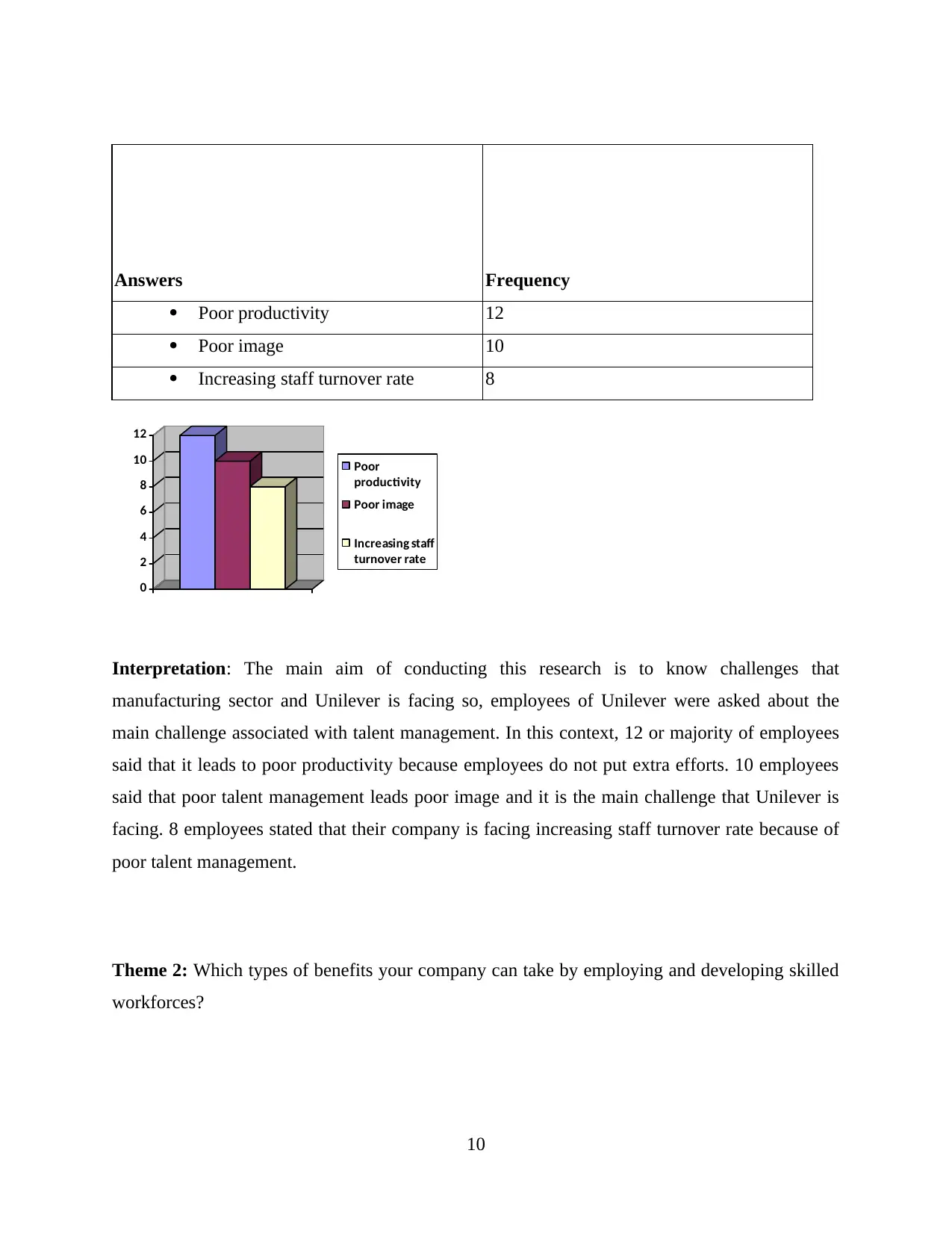
Answers Frequency
Poor productivity 12
Poor image 10
Increasing staff turnover rate 8
0
2
4
6
8
10
12
Poor
productivity
Poor image
Increasing staff
turnover rate
Interpretation: The main aim of conducting this research is to know challenges that
manufacturing sector and Unilever is facing so, employees of Unilever were asked about the
main challenge associated with talent management. In this context, 12 or majority of employees
said that it leads to poor productivity because employees do not put extra efforts. 10 employees
said that poor talent management leads poor image and it is the main challenge that Unilever is
facing. 8 employees stated that their company is facing increasing staff turnover rate because of
poor talent management.
Theme 2: Which types of benefits your company can take by employing and developing skilled
workforces?
10
Poor productivity 12
Poor image 10
Increasing staff turnover rate 8
0
2
4
6
8
10
12
Poor
productivity
Poor image
Increasing staff
turnover rate
Interpretation: The main aim of conducting this research is to know challenges that
manufacturing sector and Unilever is facing so, employees of Unilever were asked about the
main challenge associated with talent management. In this context, 12 or majority of employees
said that it leads to poor productivity because employees do not put extra efforts. 10 employees
said that poor talent management leads poor image and it is the main challenge that Unilever is
facing. 8 employees stated that their company is facing increasing staff turnover rate because of
poor talent management.
Theme 2: Which types of benefits your company can take by employing and developing skilled
workforces?
10
Paraphrase This Document
Need a fresh take? Get an instant paraphrase of this document with our AI Paraphraser
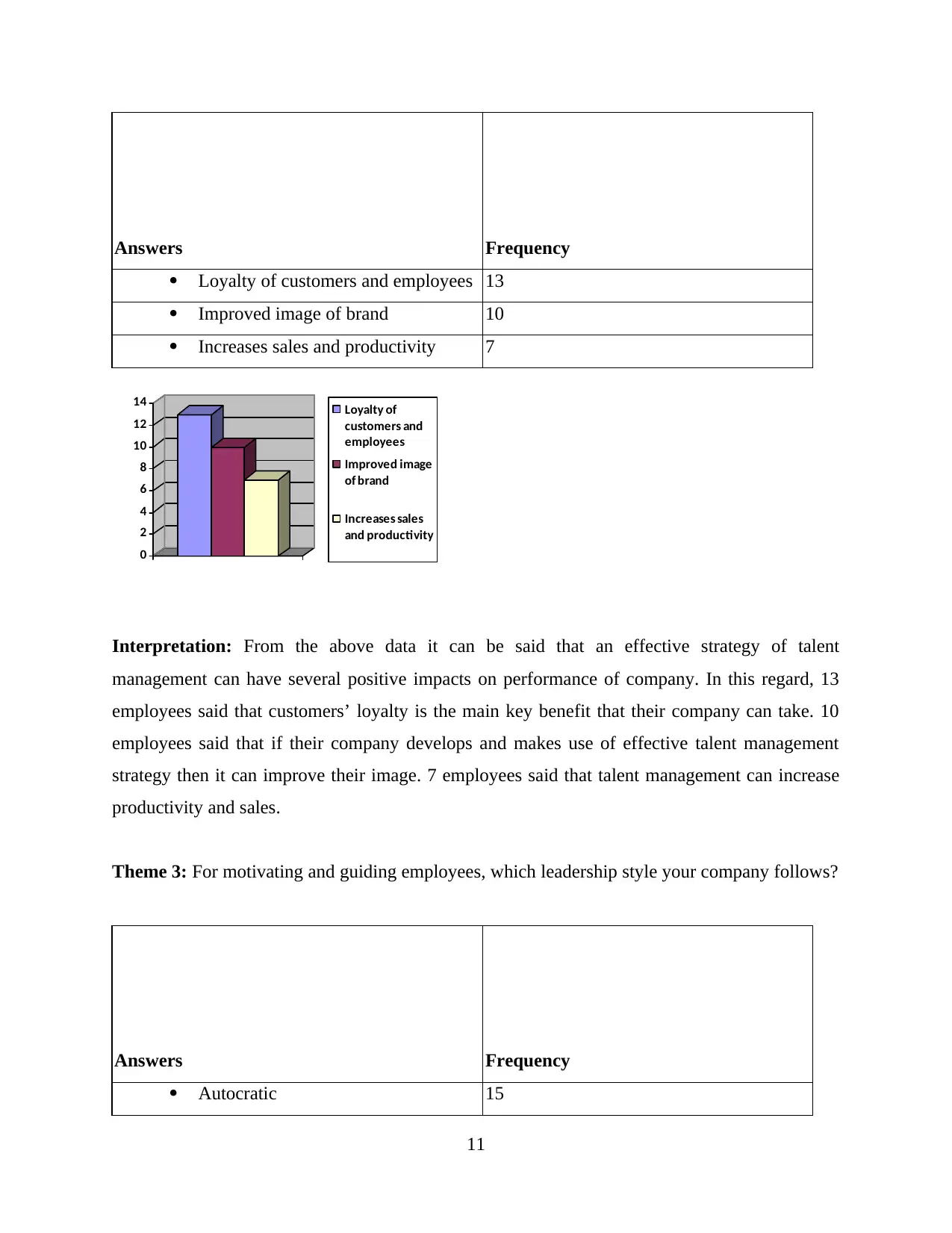
Answers Frequency
Loyalty of customers and employees 13
Improved image of brand 10
Increases sales and productivity 7
0
2
4
6
8
10
12
14 Loyalty of
customers and
employees
Improved image
of brand
Increases sales
and productivity
Interpretation: From the above data it can be said that an effective strategy of talent
management can have several positive impacts on performance of company. In this regard, 13
employees said that customers’ loyalty is the main key benefit that their company can take. 10
employees said that if their company develops and makes use of effective talent management
strategy then it can improve their image. 7 employees said that talent management can increase
productivity and sales.
Theme 3: For motivating and guiding employees, which leadership style your company follows?
Answers Frequency
Autocratic 15
11
Loyalty of customers and employees 13
Improved image of brand 10
Increases sales and productivity 7
0
2
4
6
8
10
12
14 Loyalty of
customers and
employees
Improved image
of brand
Increases sales
and productivity
Interpretation: From the above data it can be said that an effective strategy of talent
management can have several positive impacts on performance of company. In this regard, 13
employees said that customers’ loyalty is the main key benefit that their company can take. 10
employees said that if their company develops and makes use of effective talent management
strategy then it can improve their image. 7 employees said that talent management can increase
productivity and sales.
Theme 3: For motivating and guiding employees, which leadership style your company follows?
Answers Frequency
Autocratic 15
11
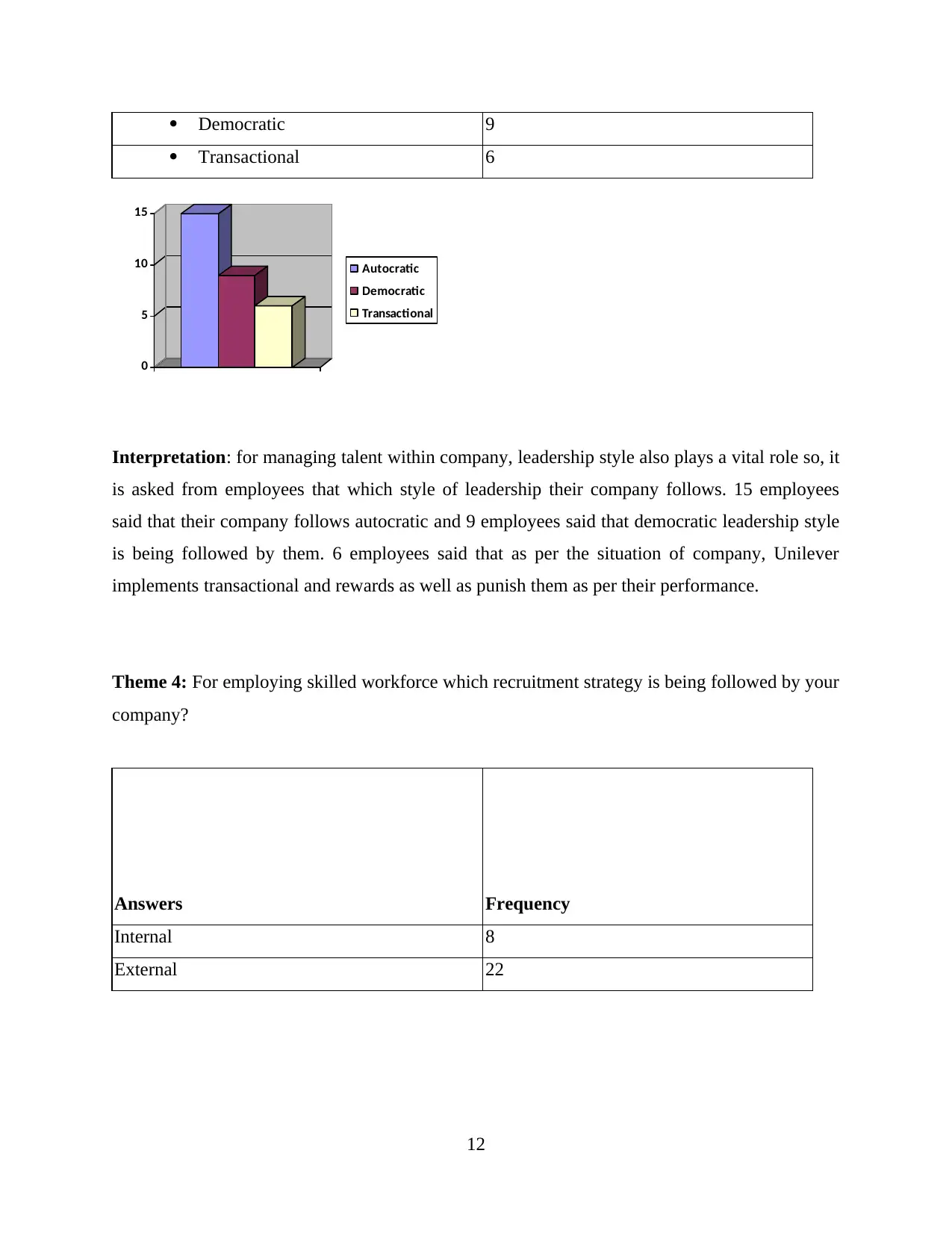
Democratic 9
Transactional 6
0
5
10
15
Autocratic
Democratic
Transactional
Interpretation: for managing talent within company, leadership style also plays a vital role so, it
is asked from employees that which style of leadership their company follows. 15 employees
said that their company follows autocratic and 9 employees said that democratic leadership style
is being followed by them. 6 employees said that as per the situation of company, Unilever
implements transactional and rewards as well as punish them as per their performance.
Theme 4: For employing skilled workforce which recruitment strategy is being followed by your
company?
Answers Frequency
Internal 8
External 22
12
Transactional 6
0
5
10
15
Autocratic
Democratic
Transactional
Interpretation: for managing talent within company, leadership style also plays a vital role so, it
is asked from employees that which style of leadership their company follows. 15 employees
said that their company follows autocratic and 9 employees said that democratic leadership style
is being followed by them. 6 employees said that as per the situation of company, Unilever
implements transactional and rewards as well as punish them as per their performance.
Theme 4: For employing skilled workforce which recruitment strategy is being followed by your
company?
Answers Frequency
Internal 8
External 22
12
⊘ This is a preview!⊘
Do you want full access?
Subscribe today to unlock all pages.

Trusted by 1+ million students worldwide
1 out of 18
Related Documents
Your All-in-One AI-Powered Toolkit for Academic Success.
+13062052269
info@desklib.com
Available 24*7 on WhatsApp / Email
![[object Object]](/_next/static/media/star-bottom.7253800d.svg)
Unlock your academic potential
Copyright © 2020–2025 A2Z Services. All Rights Reserved. Developed and managed by ZUCOL.





